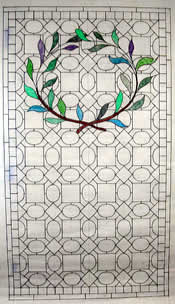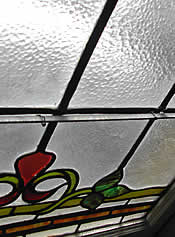|
The Stained Glass Process
 |
New Window Process
-
The new window process starts with an initial identification or a style that appeals to you (usually by looking through photos) and proceeds to a scaled color drawing.
-
A full size cartoon with lead lines can then be drawn and placed in the space for evaluation.
-
Finally, different glass can be selected for each area of the window.
|
 |
Stained Glass Window Specifications
-
All leaded glass windows pictured here are assembled with extruded lead came soldered at the joints and waterproofed with a linseed-oil based putty.
-
Lead comes in varying widths from 1/8 inch wide on its face to a full 1 inch wide and profiles include flat and rounded. (Rounded leads are stronger.)
-
Wide flat leads are usually used with larger straight pieces because they allow for on site repair of broken glass.
- Most panels require steel bars attached to the panel (or under the leads) for extra bracing.
-
Consideration should be given to leaded glass panels that have storms on the outside or inside that are not vented. Heat will build up in the space between and hasten the expansion, especially if in direct sun facing south.
|
 |
Stained Glass Doors
- In old leaded glass catalogues you often see zinc came the recommended came of choice for doors. It weighs 40% less than lead and can hold up better with constant motion over years. Unfortunately, it costs more to work with. It's not unusual for old stained glass windows to have both zinc and lead came in the same panel. Zinc came is common in beveled plate glass doors for its strength.
- More consideration should be given to a door panels support system, including round leads, leads with internal steel reinforcement, extra support bars, and wider rabbets to hold the panel in place.
|
 |
Stained Glass Repairs
-
If the leads in a panel are wide and flat enough (around 5/16 on an inch or wider) and in good enough shape, the lead came can be bent back enough to allow for a new piece of glass to be inserted without the removal of the panel from its existing opening. Zinc panels can't be repaired this way but must be removed from their opening and repaired flat on a bench.
-
Releading of stained glass windows is a last resort but may be sometimes necessary; for example if a large portion of the solder joints are broken or the panel has bowed noticeably out of plane and starts breaking glass. (Pure lead came stretches slowly with time and heat but doesn't contract thus bowing and breaking glass.)
-
Releading entails complete disassembly of a window affording full opportunity to clean glass thoroughly and repair breaks. The original glass is then reassembled using new lead of the same profile and waterproofed.
-
If your evaluating your old stained glass window, check to see if they rattle when tapped, if they do it may be that the waterproofing putty under the leads has deteriorated. The older the window, the less likely it has any putty left. Also, check to see if it's still attached to its support bars. Often flat bars are present but no longer attached to their window allowing the panel to bow or deflect. Attached flat bars are essential to keeping the panel in plane and tied into the frame for structural support.
For more info see Preservation Brief 33 commissioned by the US Department of the interior. |
|



